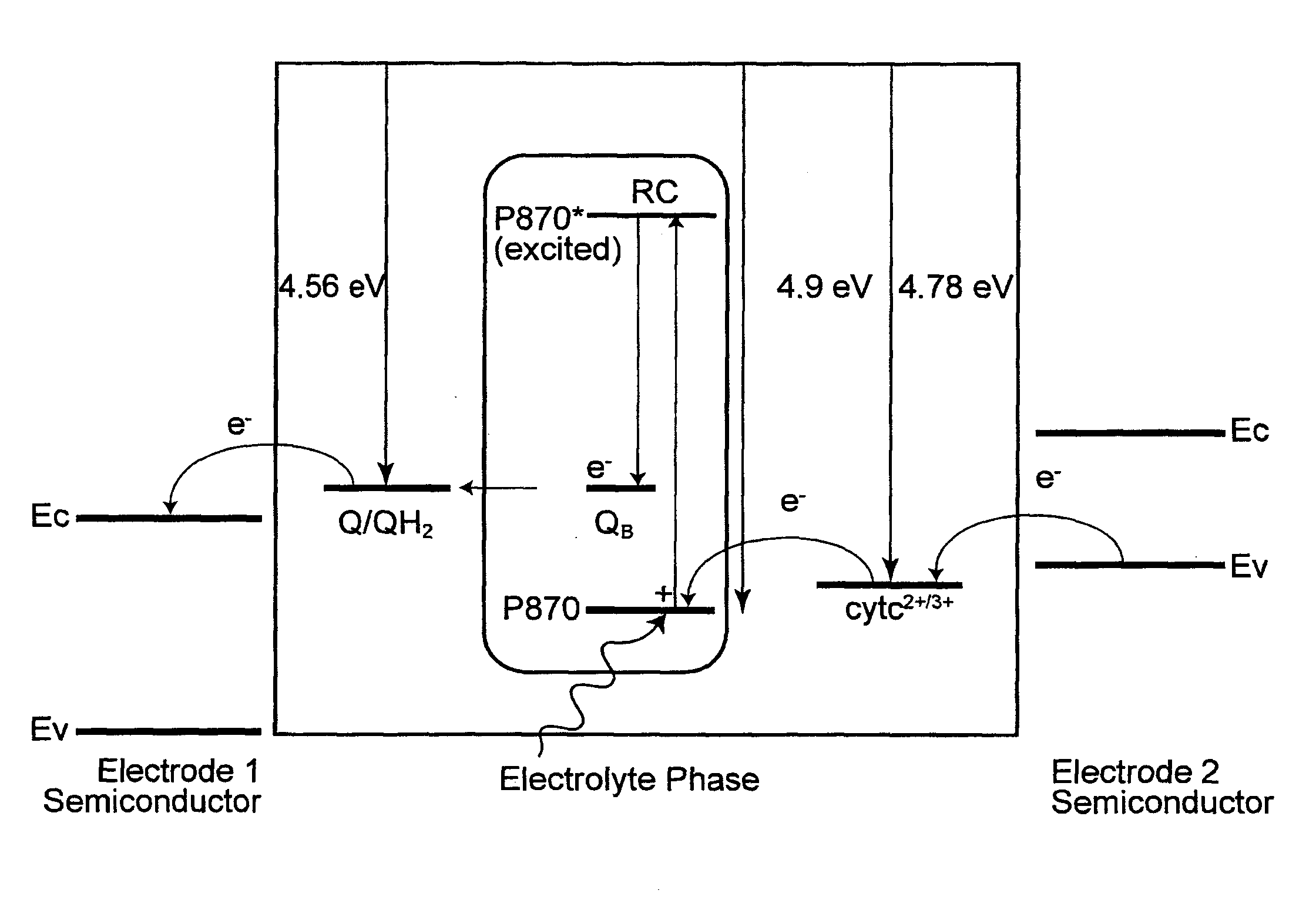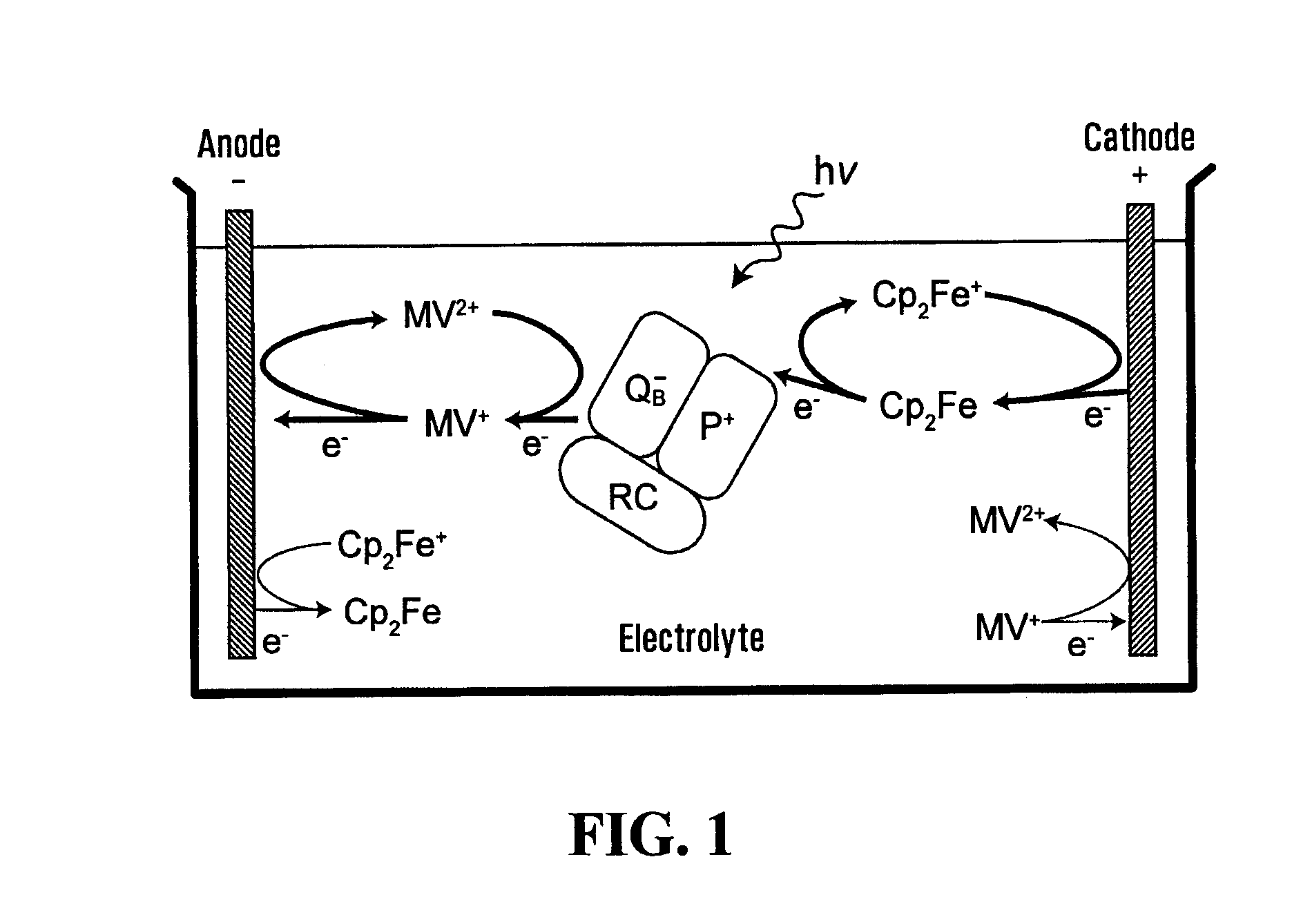Electrochemical photovoltaic cells
a photovoltaic cell and electrochemical technology, applied in the field of electrochemical photovoltaic cells, can solve the problems of low device efficiency, dssc-type devices may have a relatively short lifetime, and the rc layer may also reduce efficiency
- Summary
- Abstract
- Description
- Claims
- Application Information
AI Technical Summary
Benefits of technology
Problems solved by technology
Method used
Image
Examples
example 1
Metallic Electrodes with Non-Biological Mediators
[0041]A photovoltaic device was prepared using a 4 mL transparent cuvette as a container with a piece of highly ordered pyrolytic graphite (HOPG) and a piece of Pt wire as the anode and cathode electrodes, respectively. The electrolyte was a 100 mM Tris-HCl buffer (pH 8.0) containing 0.2 μM RC (from R. sphaeroides), 7.8 mM methyl viologen as m2 mediator, and 0.2 mM of ferrocene as m1 mediator. The RC of R. sphaeroides oxidizes ferrocene and reduces methyl viologen upon illumination. The open circuit potential of the cell shows that the cell is charged upon illumination (FIG. 2a). When the light was turned off, the voltage dropped gradually, taking more than one hour to discharge. The cell was also delivering current during and after illumination (FIG. 2b). The persistence of a current after cessation of illumination illustrates the charge storage capacity of the photovoltaic device.
example 2
Semiconducting / Metallic Electrodes with Biological Mediators
[0042]A photovoltaic device was prepared using a 4 mL transparent cuvette as a container with a piece of Tungsten Oxide (WO3) and a piece of Carbon paper as the anode and cathode electrodes, respectively. WO3 is a semiconducting material and carbon paper has metallic properties. The electrolyte was a 100 mM Tris-HCl buffer (pH 8.0) containing 5 μM RC and 80 μM quinone as m2 mediator and 80 μM of cytochrome as m1 mediator. The RC of R. sphaeroides oxidizes cytochrome and reduces quinone upon illumination. The open circuit potential of the cell shows that the cell is charged upon illumination (FIG. 3a). When the light was turned off, the voltage dropped. The cell was also delivering current during and after illumination (FIG. 3b). Again, the persistence of a current after cessation of illumination illustrates the charge storage capacity of the photovoltaic device.
example 3
Enhanced Light Absorption
[0043]A photovoltaic device was fabricated in a 4 mL glass fluorometer cuvette (1 cm×1 cm path length). Cultures of R. sphaeroides strain ΔPUHAΔPUC containing a plasmid expressing a His-tagged RC H protein were grown as previously described [Abresch et al., 2005], and the RC purified as described [Goldsmith and Boxer, 1996]. The concentration of RC after purification was 18 μM, based on the absorption peak at 804 nm. An aqueous solution of 0.75 mM Cp2Fe and 0.75 mM MV2+ (both from Sigma) in Tris-HCl buffer (pH 8), 0.1% N,N-dimethyl-dodecylamine N-oxide (LDAO), and various concentrations of the RC were used as the electrolyte. The concentration of mediators is chosen to be much higher than the RC concentration so as not to limit the photocurrent with a shortage of mediators. The solubility of ferrocene is limited to 0.8 mM. Highly ordered pyrolytic graphite (HOPG) was used for the cathode and a platinum wire for the anode [Takshi et al., 2009]. The HOPG, purc...
PUM
 Login to View More
Login to View More Abstract
Description
Claims
Application Information
 Login to View More
Login to View More - R&D
- Intellectual Property
- Life Sciences
- Materials
- Tech Scout
- Unparalleled Data Quality
- Higher Quality Content
- 60% Fewer Hallucinations
Browse by: Latest US Patents, China's latest patents, Technical Efficacy Thesaurus, Application Domain, Technology Topic, Popular Technical Reports.
© 2025 PatSnap. All rights reserved.Legal|Privacy policy|Modern Slavery Act Transparency Statement|Sitemap|About US| Contact US: help@patsnap.com



